Aug 10, 2021
WHAT CAUSES SHORELINE EROSION?
Lakeshores are areas of constant dynamic energy. Powerful waves, high water, and ice move soil particles away from shorelines. In more severe cases, small pebbles and eventually rocks begin to wash out. When the water reaches far enough up the shoreline, erosion of lawns and exposing tree roots start.
We’ll try to answer some of your questions today.
What are the leading causes of shoreline erosion?
On open water like Green Bay, the three leading causes of erosions are:
-
- Wave action;
- High water; and
- Ice movement.
The ice on frozen lakes or the Bay can expand towards the shore with a force of many tons per square foot. The ice will destroy most obstacles in its path. Masses of ice put in motion by winds can push trees or buildings over, as exhibited here.
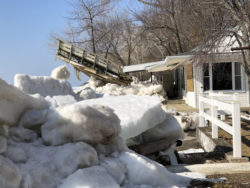
Ice vs deck erosion
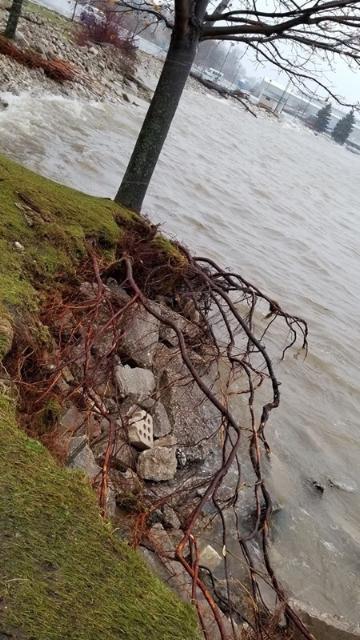
Shoreline tree roots exposed
Ice also pushes embankments, uprooting trees and lawns on small inland lakes. No matter how massive a tree is, the ice won’t slow down for it.
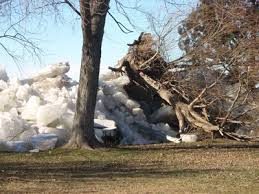
Ice Shove uprooting trees
In relatively small inland lakes, breaking waves can erode lawns away.
Headlands (points) usually have relatively high erosion rates. The waves, currents, and the ice will attack from all three sides. These attacks eventually transport the sediments to a new location where they settle in calmer weather.
Erosion is a normal process of nature.
Erosion and the redistribution of sediments is a natural process along shorelines. Typically, natural erosion proceeds very slowly. The plants and animals that live along the shore can adjust to these slow changes. They maintain a stable, healthy, productive ecosystem.
Accelerated erosion results when natural or human disturbances cause this equilibrium to be upset. Examples of this are higher than normal water levels and intense storms.
Human disturbances include vegetation removal, dredging, filling, or construction near the shoreline.
Another example of natural disturbances is large trees uprooted by a windstorm or a flood. When the soil becomes saturated with water, it weakens the soil around tree roots. The winds may uproot that tree.
IDENTIFY SERIOUS EROSION PROBLEMS
These are several signs of severe erosion problems. (Number one and three are significant)
- A large area of bare soil on a steep, high shoreline bank;
- A measurable change of the shoreline over time;
- Leaning or downed trees with exposed roots; and
- Large patches of muddy water near a lakeshore during periods of high water or following a rainstorm.
3 TYPES OF REACTIVE EROSION CONTROL METHODS:
Vegetative/No Mow: This method involves encouraging or planting trees or woody shrubs for the soil binding properties of their root systems. Grass and other plants will protect against raindrop impact and scouring from surface runoff.
Structural: This includes protective structures. The placement of rock of various sizes (rip-rap) has traditionally been the most effective and least expensive method.
Other structural methods include bulkheads, gabions (rock-filled baskets), and railroad ties. However, these methods are visually unappealing. They require more heavy equipment and technical expertise. These systems are more prone to failure than simple rip-rap. In addition, the DNR has disapproved of these methods in the past.
Manipulative: Mostly used on streams, this includes:
-
-
- Removing streamflow obstructions;
- Grading shoreline banks, or, in exceptional circumstances;
- Rerouting a stream channel.
Are there new techniques developed to prevent erosion?
A new soil preservation method called bioengineering has been proven successful.
Soil bioengineering combines mechanical, biological, and ecological concepts. These methods arrest and prevent shoreline erosion. An example is planting willows interspersed with rip-rap, where the rock provides immediate resistance to decay.
As the willows become established, roots invade and permeate the rock and underlying soil. They bind them together into an erosion-resistant mass. The willows also impart a more “natural” look to the shoreline.
Water levels are down; I don’t have to worry – Right??
This year, people do see water levels about 18-24″ less than in 2020. High water levels are the most significant contributing factor to shoreline erosion.
Will it stay down next year or in the years after? No one knows. In Las Vegas, that’s called a crapshoot.
What other factors affect my shoreline?
The next factor is the intensity of the storms. The Door County Peninsula had numerous high wind storms this year with up to 70 MPH winds.
A popular Marina in Sturgeon Bay: Skipper Bud’s Harbor Marina, located at the foot of the Michigan St. bridge, was a victim of a recent storm.
The marina had two of its five floating docks torn loose during a strong storm. Two tub boats quickly moved in place to prevent them from swinging into the bridge.
Are there other contributing factors to shoreline erosion?
You can expect water levels to rise rapidly when winds blow from the NW – NE direction for prolonged periods. This is despite the lower water levels this year. The stronger the winds, the higher the water will go. Waters south of Sturgeon Bay are particularly affected by these winds. In those areas, there are no other large outlets for the water to escape.
DO YOU NEED AN ESTIMATE FOR RIP-RAP?
Contact Dave@ 920-493-4406 or email at Dave@wisconsinpws.com.
What comes next?
Next week (on Aug 10, 2021), we will cover:
-
-
-
-
- Planning an erosion control project;
- Does erosion hurt my property values?
- What to expect for the cost of rip-rap.
Where is Pier & Waterfront Solutions?
Located at 7325 St. Hwy 57, it’s 3 miles south of Sturgeon Bay and 1 mile past the intersection of Cty MM (heading north). Look on the right side, one mile north, at the next corner (Idlewild Road and Hwy 57).
Is PWS OPEN?
The “Delta” variant is currently surging across the country.
Pier & Waterfront Solutions remains “open.” We have implemented measures to help protect the safety of our employees and visitors. PWS continues to work to maintain the trusted service that you have come to expect.
PWS implemented these preventive measures:
- Conducting as much business as possible by email, text, or phone.
- Site visits will continue.
- When in-person contacts are necessary, we follow “social distancing” guidelines.
- Our display yard is always open for you to examine at your leisure.
- All displays have a numbered, red tag on them. For more information, please reference that number.
What can YOU do to help us?
1. Conduct as much business as possible via emails, messaging, and emails.
2. When you see our crews installing equipment, please practice “social distancing.”
Thank you for allowing us to work with you.
YES – PWS is OPEN and waiting for you!
Please call, message, or email PWS with any questions.
Let’s all stay safe!
Aug 3, 2021
PIER & WATERFRONT SOLUTIONS
It’s been a fast-moving six months since our last article about PWS.
Dave Kalista and Jerry Englebert started in 2015. Like all new business owners, they were willing to put their futures on the line.
The first “office” consisted of a tiny room that was so small that you had to walk sideways to get to the table. It was the size of a closet in a new home.
All-Terrain Forklift
PWS tested an ATF that buried itself in the soft shoreline at Sugar Creek Park. It became clear that the machine would not work.
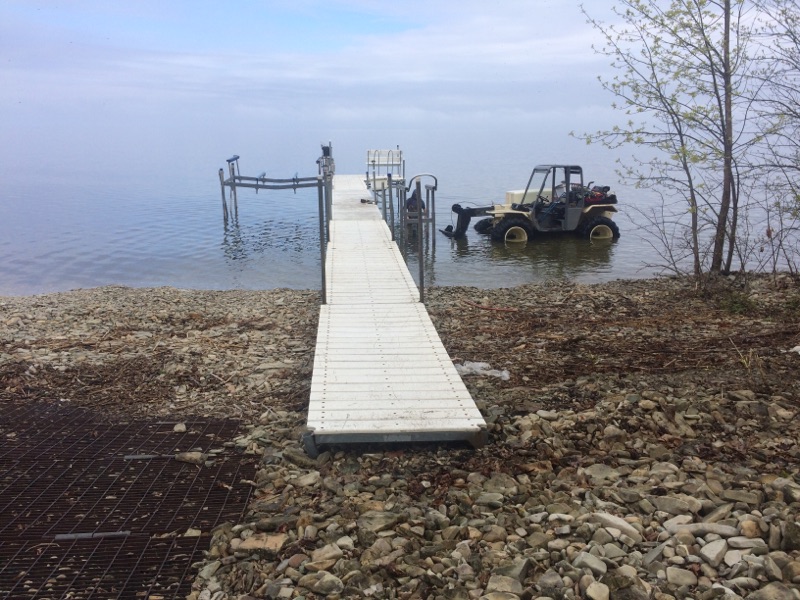
ATF for dock install
PWS bought the 1st All-Terrain Forklift and modified it to handle the conditions they would encounter.
While Jerry made sales, installs were done by hand or by using the All-Terrain Forklift. Dave operated the ATF along with Alex, our first employee. Alex is with us today and has his own crew.
PWS expanded
Pier & Waterfront Solutions moved out of the “closet” and into an office on Hwy 57 (our current location).
Today, manufacturing, a welding operation, and an assembly area occupy the warehouse. We still have room for a limited amount of equipment storage.
2016-2021 saw more ATF’s, crews, and trailers added – five ATF’s to be exact.
Meanwhile, the one-room office has grown into three offices. These offices accommodate the office staff of six required to handle the growing business.
PWS EXPANDED AGAIN
During late 2018 the Great Lakes and Green Bay experienced record water depths. The resulting damages included the loss of many shorelines. Trees and up to 50 feet of lawn washed away at some locations.
PWS responded by expanding its rip-rap business. PWS remains the only dock and boat lift company on the Door County peninsula to do so.

Enlarged 36′ x 45″ Barge
As the rip-rap business grew, we introduced a 24′ x 45′ barge and pusher boat. PWS needed the barge to protect the customer’s landscaping from damage.
In 2021, PWS added another section to the barge, making it a 36″ x 45′ barge. It continues to service both sides of the peninsula from Milwaukee to the tip of Door County.
Why such a large barge?
The barge allows PWS to transport excavators, track-mounted skid steers, and tons of boulders to the work sites from the waterside.
There is no damage to the landscaping.
It’s more economical for the homeowner, in most cases, and gives us access to areas that aren’t accessible by land.
GALVANIZED DOCK – NEXT INTRODUCTION
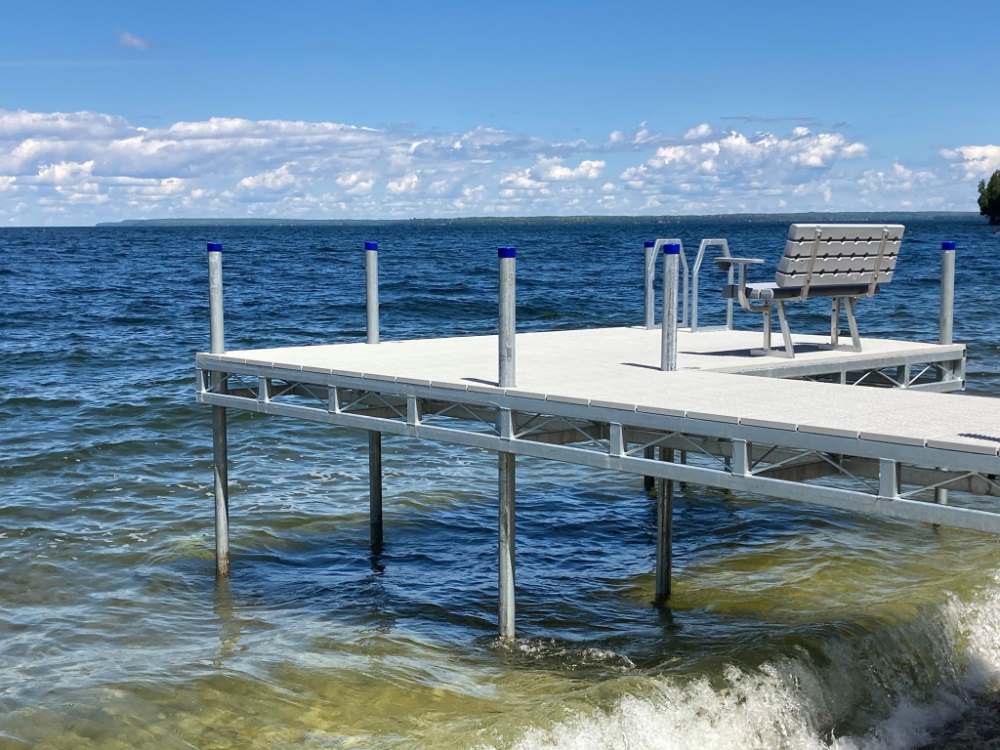
3-Season Pier
PWS developed a line of galvanized steel docks. The new docks use the best materials available today. Most steel docks are too light to handle the storms in open areas. Other models lacked the open-deck design of the 3-Season Pier.
After two years of testing, PWS introduced the 3-Season Pier. As a heavier, more robust steel pier, it is unmatched on Lake Michigan.
One of the features of the 3-Season Pier is a 25% larger platform. That’s more room for entertaining. Plus, it’s not a “special order.” “Special Order” is just another way of saying – more expensive.
The 3-Season Pier is available in 4′, 5′, and the prestigious 6′ width. The 3-Season Pier handles the high water and the strong storms you experience today.
The strength and dependability are evident when you look for a dock that will be around for a long time.
What was next?
The rapidly expanding business required more innovation to keep up with demand. In 2021, PWS added another barge. This time, equipped with a movable crane.
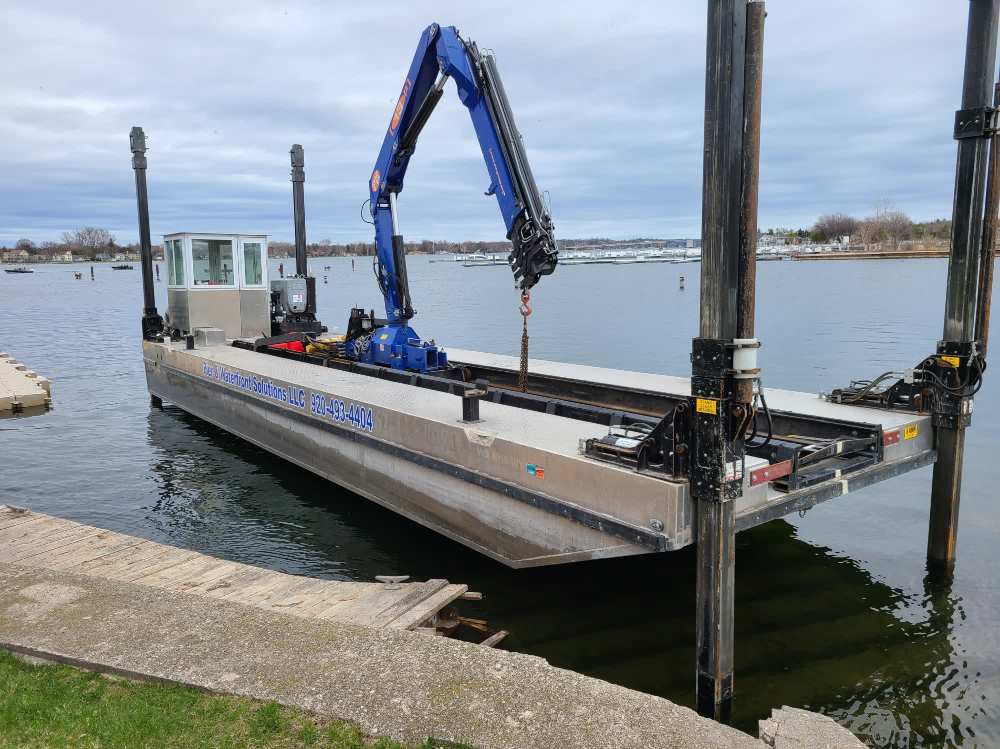
Barge w/ crane for dock removal
The “Small” barge (12′ x 45′) contains an articulating crane with a 60′ reach. The “small barge” eliminates the need for shore access by heavy equipment. The new crane also means reduced damage to a homeowner’s landscaping.
As Door County continues to build, land access for our equipment is diminishing. In the past, empty lots served as access to the shorelines. Today those lots are fully developed with manicured lawns and huge homes. In some areas, water access is the only available route.
What has happened to the Dock market in Door County?
The unexpected closure of an old dock business in Door County resulted in an influx of new customers. PWS is already planning its next moves to handle a large number of new customers. We plan to have everything ready for Spring 2022.
How will you find out about these changes?
The best way is to come back here each week and follow these posts on our website.
Summary
PWS already had the strongest aluminum dock as part of the ShoreMaster line. Now PWS has the strongest galvanized steel dock.
Call Jerry today. (920-493-4404) or email him at jerry@wisconsinpws.com or use this request form.
Tell Your Friends & Family
Visit Pier & Waterfront Solutions on Facebook.
Where is Pier & Waterfront Solutions?
Located at 7325 St. Hwy 57, it’s 3 miles south of Sturgeon Bay and 1 mile past the intersection of County MM (heading north). Look on the right side, one mile north, at the next corner (Idlewild Road and Hwy 57).
Is PWS OPEN?
Pier & Waterfront Solutions never closed. We have implemented measures to ensure the safety of our employees and visitors. We are working to maintain the trusted service that you have come to expect.
PWS implemented precautionary measures:
1. Conducting as much business as possible by email, text, or phone.
2. Site visits continue. When in-person contacts are necessary, we will follow “social distancing” guidelines.
3. Our display yard is always open for you to examine at your leisure. All displays have a numbered, red tag on them. If you want more information or pricing, please reference that number.
What can YOU do to help us?
1. Please conduct as much business as possible via emails, messaging, and emails. This step protects everyone involved.
2. When you see our crews installing equipment, please practice “social distancing.”
Thank you for allowing us to work with you.
YES – PWS is OPEN and waiting for you!
Please call, message, or email PWS with any questions.
Let’s all stay safe!
Aug 3, 2021
NEED A NEW STAIRWAY?
Is the wood on the stairway to the beach rotted? Are those flat stones moss-covered, tilted, and slippery? Are the railings loose? And most importantly – Would your favorite grandmother feel safe walking down to the beach?
Just need to add handrails? PWS does that, too.
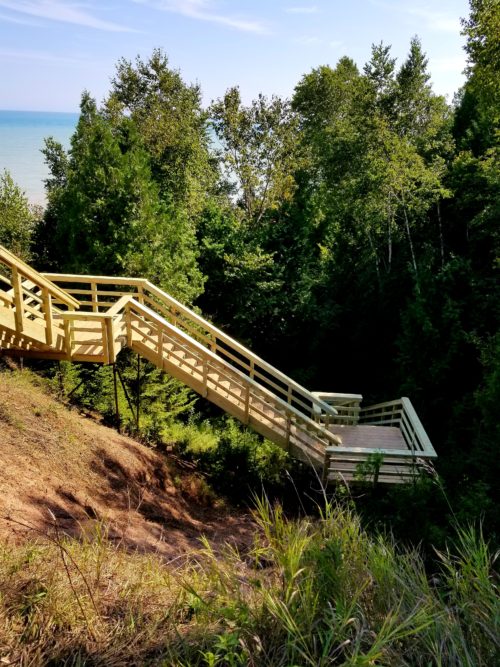
Side view of stairs
What if it’s a long walk? Do you need a place to “rest” along the way? PWS places landings wherever required.
Did you answer YES??
If you answered “YES” to any of these questions, you need to talk to Jerry at Pier & Waterfront Solutions.
Do it today!!
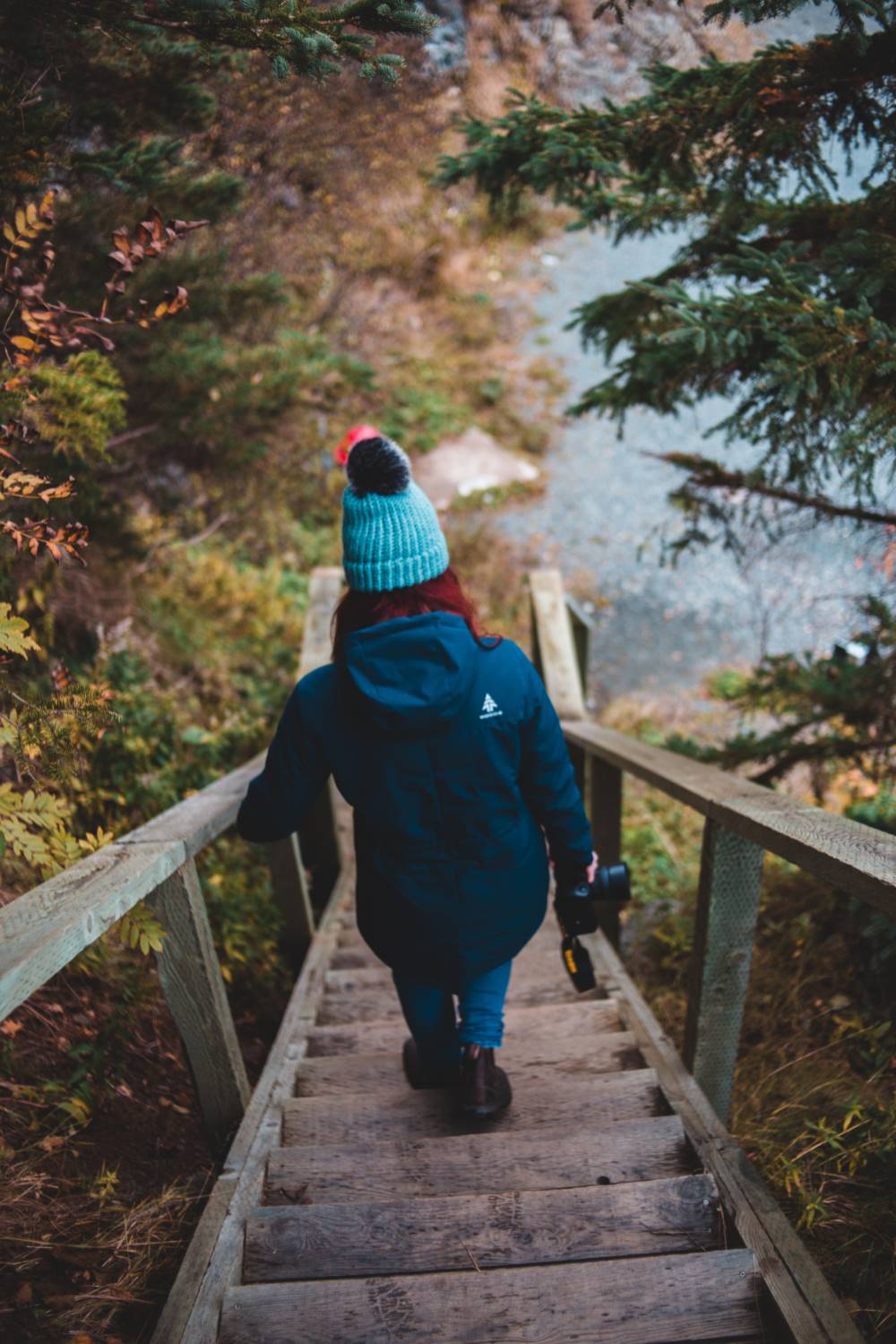
Steep stairway
PWS works with wood or steel frames along with the materials you specify.
Why risk slipping on the walk down to the beach? PWS can repair or replace it with stairs that you feel comfortable and safe walking on.
Your family and guests deserve a safe way to get to the water.
Trust PWS for all things beach-related – including getting there.
We will remove and dispose of the old decks, stairs, and docks as part of our service. Just sit back and watch our crews do the work for you.
Make getting to the beach safe again for your family and friends. Even grandma will like it.
WHY WAIT??
Call Jerry today. (920-493-4404) or jerry@wisconsinpws.com
Here’s another way to start the process – use this simple quote request form. We’ll be in touch.
Pier & Waterfront Solutions has the solution for you!!
Tell Your Friends & Family
Have friends or neighbors you believe should see this article? Email them this link – and Thank you!
Visit Pier & Waterfront Solutions on Facebook too.
Where is Pier & Waterfront Solutions?
Located at 7325 St. Hwy 57, it’s 3 miles south of Sturgeon Bay and 1 mile past the intersection of Cty MM (heading north). Look on the right side, one mile north, at the next corner (Idlewild Road and Hwy 57).
Is PWS OPEN?
Pier & Waterfront Solutions has remained “open.” We have implemented measures to ensure the safety of our employees and visitors. At the same time, we are working to maintain the trusted service that you have come to expect.
PWS implemented these precautionary measures:
1. Conducting as much business as possible by email, text, or phone.
2. Site visits will continue. When in-person contacts are necessary, we will follow “social distancing” guidelines.
3. Our display yard is always open for you to examine at your leisure. All displays have a numbered, red tag on them. If you want more information or pricing, please reference that number.
What can YOU do to help us?
1. Please conduct as much business as possible via emails, messaging, and emails. This step protects everyone involved.
2. When you see our crews installing equipment, please practice “social distancing.”
Thank you for allowing us to work with you.
YES – PWS is OPEN and waiting for you!
Please call, message, or email PWS with any questions.
Let’s all stay safe!
Jul 27, 2021
COMPARE A JUMBO JET TO OPEN DECKING
You’ve flown. Whether it’s 100 or 1,000 miles, it’s the same principle.
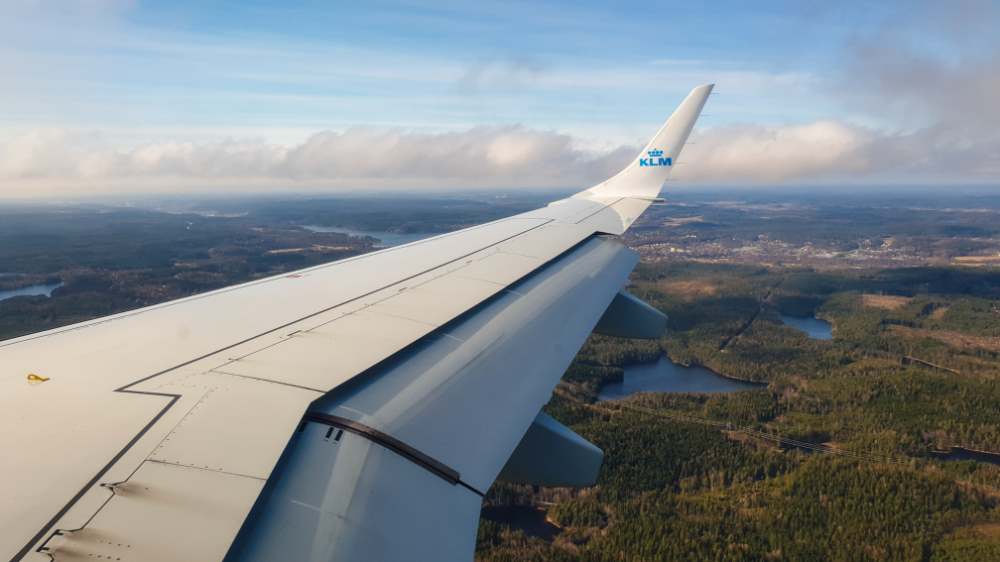
Airplane Flaps
Credit: Miguel Ángel Sanz
While landing at 125 MPH, a plane uses its “flaps” to provide extra “lift” when the forward speed is insufficient to keep the aircraft in the air. Flaps are those pieces of metal that roll out of the wing to slow the plane down while providing extra lift.
The added “lift” caused by the extended “flaps” maintains enough “lift” and surface area to keep the plane flying for a controlled landing.
What if the flap resistance was reduced to less than 60%?
What would happen if the flaps had “holes” in them. If you reduced the surface area by over 40%, what would happen? The answer is simple – the plane would soon be a pile of scrap metal.
By reducing the surface area of the flaps, air would pass right through, and the “lift” the pilot needed to stay airborne would disappear.
A plane needs the flaps’ resistance to help slow the aircraft when landing to maintain control.
The idea of resistance against the flaps works great for an airplane – not so much for your dock.
What has that got to do with open decking?
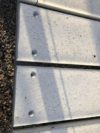
Typical Plank decking
That same principle of “lift” applies to your dock. Older docks have wood, aluminum, or plastic board decking. Despite the 1/2″ opening between the deck pieces, the decking is essentially a solid mass. When a wave comes up under the decking, the water tries to push the decking up.
Here’s where you have a choice.
With bolted-down decking, the wave is trying to lift the entire structure.
If you leave the decking loose, you risk losing that piece(s) of decking. Sometimes the pieces float a short distance and sink. You can recover them with a bit of effort.
The other side of the coin is they float too far away, and you end up purchasing new pieces.
What about “open decking”?
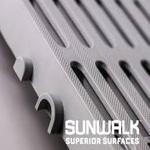
Open Decking
The open decking is like the “flaps” with holes in them. There is so much less surface area- 42% less – that the “lift” pressure is greatly reduced. The likelihood of lifting or flipping your dock over is significantly reduced.
We have to salvage many of the bolted down, solid plastic docks when the end lifts up and flips over. Usually, this causes the entire pier to flip over.
It’s like a train where the lead cars go off the track. Because they are connected to the next car, they all (or mostly all) flip over. The same is true with a dock.
You end up with twisted frames, which are a complete loss.
Is open decking hot to walk on?
No, for the same reason they are less likely to “lift” the dock. Those holes or slots rapidly dissipate the heat. The air passes through them and takes the heat away.
Does it get slippery when wet?
The shape of the slots allows the water to run off. The decking does not get “cupped,” which holds the water like the solid plastic boards. Besides, there are dimples on the walking surface to add traction.
It looks hard to walk on.
No, most people find open decking comfortable to walk or lay on.
Summary
Besides all the benefits noted above, the open decking costs LESS than other types of decking. These benefits are yours when you buy open decking from PWS.
Now pair these benefits with the PWS 3-Season Pier, and you have the best value for your money.
Call Jerry today. (920-493-4404) or jerry@wisconsinpws.com
Tell Your Friends & Family
Have friends or neighbors you believe should see this article? Email them this link – and Thank you!
Visit Pier & Waterfront Solutions on Facebook.
Where is Pier & Waterfront Solutions?
Located at 7325 St. Hwy 57, it’s 3 miles south of Sturgeon Bay and 1 mile past the intersection of Cty MM (heading north). Look on the right side, one mile north, at the next corner (Idlewild Road and Hwy 57).
Is PWS OPEN?
Pier & Waterfront Solutions has remained “open.” We have implemented measures to ensure the safety of our employees and visitors. At the same time, we are working to maintain the trusted service that you have come to expect.
PWS implemented these precautionary measures:
1. Conducting as much business as possible by email, text, or phone.
2. Site visits will continue. When in-person contacts are necessary, we will follow “social distancing” guidelines.
3. Our display yard is always open for you to examine at your leisure. All displays have a numbered, red tag on them. If you want more information or pricing, please reference that number.
What can YOU do to help us?
1. Please conduct as much business as possible via emails, messaging, and emails. This step protects everyone involved.
2. When you see our crews installing equipment, please practice “social distancing.”
Thank you for allowing us to work with you.
YES – PWS is OPEN and waiting for you!
Please call, message, or email PWS with any questions.
Let’s all stay safe!
Jul 20, 2021

Introducing ……….
Our new HR/Finance Manager
Lynn Bretl
Lynn has worked in the complex finance world for over 20 years with great success.
Now, as the PWS Human Resource and Finance Manager, Lynn is responsible for accounts payables & receivables, taxes and HR duties. Along with Keri, our Service Manager, Lynn, produces the final billing you see.
She creates spreadsheets and all the other duties that go with this increasingly diversified and complex business.
About 5 years ago, Lynn grew into the human resource sector. Lynn now handles our payrolls, government tax reports and works with several types of insurance.
When you have a question about your billing, Lynn helps explain those questions.
The wide variety of work appeals to her and keeps it exciting and challenging.
Lynn has only worked at Pier & Waterfront Solutions for a short time. Still, she has found a warm, caring, family atmosphere here.
Along with Keri, Lynn will help to resolve your billing questions should the need arise.
Contact Lynn at – lynn@wisconsinpws.com or by phone at 920-493-4406.
Jul 15, 2021
CIRCLE OF DEATH
If you have a boat under 26 feet, the attached information is for you!
There have been many incidents resulting in mangled bodies and death. Please read this immediately.
Kill Switch Regulation Details announced by U.S. Coast Guard today, 10 March 2021.USCG News Release
News Release
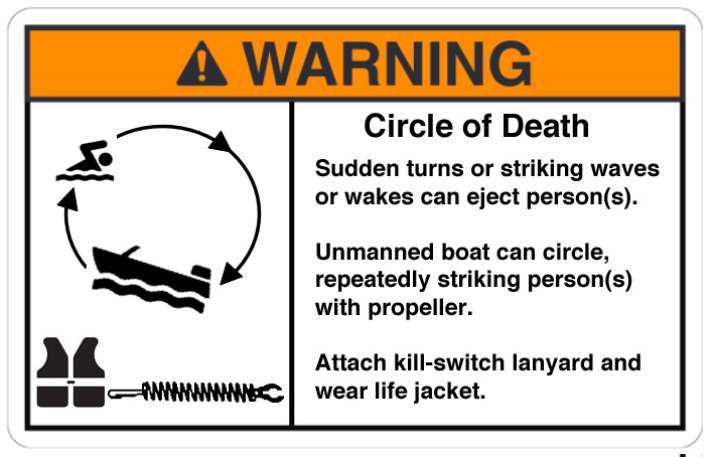
CIRCLE OF DEATH
U.S. Coast Guard Headquarters
Contact: Headquarters Public Affairs
Headquarters online newsroom
U.S. Coast Guard Announces New Law Requiring Use of Engine Cut-off Switches
WASHINGTON – Operators of recreational vessels less than 26 feet in length will be required to use an engine cut-off switch (ECOS) and associated ECOS link (ECOSL) as of April 1, 2021 as the U.S. Coast Guard implements a law passed by Congress.
The ECOS and ECOSL prevent runaway vessels and the threats they pose. The ECOSL attaches the vessel operator to a switch that shuts off the engine if the operator is displaced from the helm. The ECOSL is usually a lanyard-style cord that attaches to an ECOS either in close proximity to the helm or on the outboard motor itself if the vessel is operated by a tiller. When enough tension is applied, the ECOSL disengages from the ECOS, and the motor is automatically shut down. Wireless ECOS have recently been developed and are also approved for use. These devices use an electronic “fob” that is carried by the operator and senses when it is submerged in water, activating the ECOS and turning the engine off. Wireless devices are available on the aftermarket and are beginning to become available as manufacturer-installed options.
Each year the Coast Guard receives reports of recreational vessel operators who fall or are suddenly and unexpectedly thrown out of their boat. These events have led to injuries and deaths. During these incidents, the boat continues to operate with no one in control of the vessel, leaving the operator stranded in the water as the boat continues on course, or the boat begins to circle the person in the water, eventually striking them, often with the propeller. These dangerous runaway vessel situations put the ejected operator, other users of the waterway, and marine law enforcement officers, and other first responders in serious danger.
Section 503 of the Coast Guard Authorization Act of 2018 required manufacturers of covered recreational boats (less than 26 feet in length, with an engine capable of 115 lbs. of static thrust) to equip the vessel with an ECOS installed as of December 2019. Owners of recreational vessels produced after December 2019 are required to maintain the ECOS on their vessel in a serviceable condition. It is recommended that recreational vessel owners regularly check their existing ECOS system to ensure it works, following manufacturer’s instructions.
Section 8316 of the National Defense Authorization Act of 2021 requires individuals operating covered recreational vessels (less than 26 feet in length, with an engine capable of 115 lbs. of static thrust; 3 HP or more) to use ECOS “links.” Using the ECOSL is required only when the primary helm is not within an enclosed cabin and when the boat is operating on a plane or above displacement speed. Common situations where ECOSL use would not be required include docking/trailering, trolling, and operating in no-wake zones.
The Coast Guard believes that the overwhelming majority of recreational vessels produced for decades have had an ECOS installed, so this new use requirement simply obligates recreational vessel operators to use critical safety equipment already present on their boat.
Seven states currently have ECOS use laws for traditional recreational vessels, and 44 states have ECOS use laws for personal watercraft (PWC).
Boaters are encouraged to check the U.S. Coast Guard website for additional information on this new use requirement and other safety regulations and recommendations:
https://uscgboating.org/recreational-boaters/Engine-Cut-Off-Switch-FAQ.php
-USCG-



















